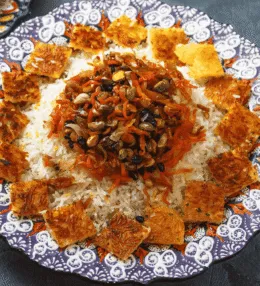
- View
Table of Contents
ToggleCarnitas, a traditional Mexican dish, is the ultimate celebration of slow-cooked pork. The name itself means “little meats,” but don’t let that simplicity fool you, this dish is packed with flavour and history.
Tender, succulent pork, cooked low and slow until its melt-in-your-mouth delicious, is a staple of Mexican cuisine. Whether piled into warm tortillas, served alongside rice, or simply enjoyed on its own, Carnitas offers a taste of Mexico’s rich culinary heritage with every bite.
Want to dive deeper into Mexican Cuisine? Don’t miss our post on 25 Traditional Mexican Foods To Try
What Is Carnitas?
Carnitas is a dish that revolves around pork, typically made from the shoulder or leg, slow-cooked in its own fat until it reaches the perfect balance of tenderness and crispiness. The process of slow-cooking allows the fat to render down, infusing the meat with a rich, savoury flavour.
Traditionally, Carnitas is prepared in large copper pots, where the pork is cooked until its fall-apart tender on the inside, but crispy and golden on the outside.
Once cooked, the pork is shredded into bite-sized pieces, making it perfect for tacos, tortas, or just about any dish you want to add a burst of flavour to.
What makes Carnitas so special is the texture: tender, juicy, and with just enough crisp from the frying process to give it that satisfying crunch. It’s a dish that embodies the art of slow-cooking, taking time and care to extract every bit of flavour from the pork.
Ingredients and Taste
The core ingredient of Carnitas is, of course, pork, usually from the shoulder, as it has the right balance of fat and meat to ensure a rich, succulent final product.
The pork is seasoned with salt and often flavoured with spices like cumin, garlic, bay leaves, and oregano, though the exact combination can vary by region or family tradition.
Some recipes even add a hint of citrus, such as orange or lime, which brightens the flavour and adds a subtle tang.
As the pork cooks slowly in its own fat, it absorbs the flavours of the spices, transforming into a dish that’s deeply savoury, with layers of smoky, aromatic goodness.
The exterior becomes crispy, while the inside remains juicy and tender, creating a perfect contrast of textures. The subtle hint of citrus or herbs enhances the richness of the pork, making every bite more complex than the last.
When served, Carnitas is often accompanied by soft corn tortillas, fresh salsa, diced onions, and cilantro. The freshness of these toppings balances the richness of the pork, creating a dish that is vibrant, flavourful, and satisfying.
A Taste of History
Carnitas has its origins in the state of Michoacán, Mexico, where it has been a traditional dish for centuries. The method of slow-cooking pork in its own fat is a technique that has been passed down through generations, reflecting the importance of patience and care in Mexican cooking.
Copper pots, often used in the process, are still revered in Michoacán, and many cooks believe they create the perfect conditions for achieving Carnitas’ signature texture.
Historically, Carnitas was a dish prepared for special occasions and celebrations, as the process of cooking the pork was often a communal event, requiring both time and effort.
The use of large pots allowed for enough Carnitas to feed a crowd, making it ideal for gatherings. Over time, Carnitas became more widely available, but it still holds a place of honour at Mexican family feasts and festivals.

Carnitas (Mexican Slow Cooked Pork) Recipe
Ingredients
- 1.5 kg pork shoulder boneless, cut into large chunks
- 1 large onion quartered
- 4 garlic cloves smashed
- 1 orange juiced (reserve the peel)
- 2 tsp salt
- 1 tsp black pepper
- 1 tsp cumin
- 1 tsp dried oregano
- 2 bay leaves
- 1 cinnamon stick
- 1 cup lard or vegetable oil
- 1/2 cup water
Instructions
- Preheat your oven to 150°C (300°F). In a large bowl, combine the pork shoulder chunks, salt, black pepper, cumin, and oregano. Mix well to coat the pork evenly with the seasoning. This helps infuse the meat with deep, robust flavors.
- Heat a large Dutch oven or heavy-bottomed pot over medium heat. Add the lard (or oil if preferred), and once hot, sear the pork in batches until browned on all sides, about 3-4 minutes per side. This step locks in moisture and adds a rich crust to the pork.
- Once the pork is seared, remove it from the pot and set aside. In the same pot, add the quartered onion, garlic, bay leaves, cinnamon stick, and the reserved orange peel. Cook for about 2-3 minutes until fragrant, which builds the aromatic base of the carnitas.
- Return the seared pork to the pot, nestling it among the onion and spices. Pour in the fresh orange juice and water to deglaze the pot, scraping any browned bits from the bottom to enhance the flavour.
- Cover the pot with a lid or aluminium foil, ensuring a tight seal, and transfer it to the preheated oven. Let the pork cook slowly for 3 hours, or until the meat is tender and easily shredded. This low, slow cook method allows the pork to develop its signature melt-in-your-mouth texture.
- After 3 hours, check the pork for tenderness. Remove the lid and increase the oven temperature to 200°C (400°F). Cook uncovered for an additional 20-30 minutes to allow the pork to crisp on the edges while remaining tender inside.
- Remove the carnitas from the oven and carefully shred the pork using two forks. Discard the cinnamon stick, orange peel, and bay leaves. If desired, toss the shredded pork in the remaining juices in the pot to keep it moist and flavourful.
- Serve the carnitas hot with fresh tortillas, salsa, chopped cilantro, and lime wedges. You can also accompany them with pickled onions or guacamole for extra flavour. For added crunch, crisp up some of the carnitas under the broiler for a few minutes before serving.
Nutrition
You May Also Like






